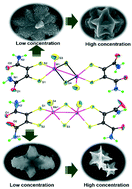Structural control in the nanoassembly of the tungsten and molybdenum dithiolene complex analog†
Abstract
Structural control at the nanoscale via self-assembly toward ordered and well-defined material hierarchies is a critical aspect for the fabrication of functional nanostructures. Herein, the tunable manipulation of the self-assembly of dithiolene complexes to controlled morphology directed by concentration variation is reported. Dimeric tungsten(V) (1) and molybdenum(V) (2) dithiolene–diamide complexes were synthesized and structurally characterized by the single-crystal X-ray diffraction method. Interestingly, the trans-(W2S4) core is present in 1 in contrast to the cis-(Mo2S4) core in 2 in these analogous complexes. DFT calculations show that the trans form of 1 is stabilized from its cis form by 8 kcal mol−1, whereas the stable cis form of 2 is stabilized from its trans form by 30 kcal mol−1. This variation in the positional terminal sulfide ligand in 1 and 2 is reflected in the respective lattice packing. Such packing controls the self-assembly process to aggregate into different floral shapes in the nanodomain and on increasing the concentration of 1 or 2 results in nanopolyhedral shapes. Such structural control of concentration-driven self-assemblies provides future opportunities to engineer technologically desired nanostructures with complex architectures.

- This article is part of the themed collection: Emerging Investigator Series


 Please wait while we load your content...
Please wait while we load your content...